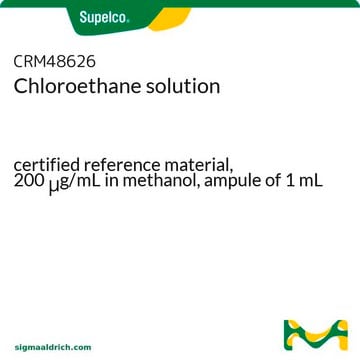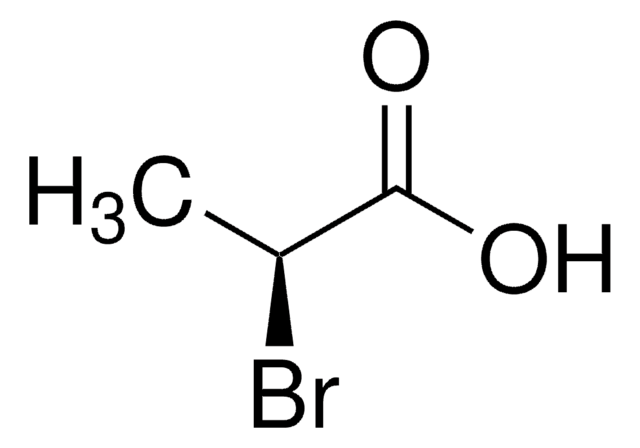139130
Methyl 2-chloropropionate
97%
Synonym(s):
(±)-Methyl 2-chloropropionate
Sign Into View Organizational & Contract Pricing
All Photos(1)
About This Item
Linear Formula:
CH3CHClCOOCH3
CAS Number:
Molecular Weight:
122.55
Beilstein:
1421535
EC Number:
MDL number:
UNSPSC Code:
12352100
PubChem Substance ID:
Recommended Products
vapor density
4.22 (vs air)
vapor pressure
5.25 mmHg ( 20 °C)
Assay
97%
expl. lim.
19 %
refractive index
n20/D 1.417 (lit.)
bp
132-133 °C (lit.)
density
1.075 g/mL at 25 °C (lit.)
SMILES string
COC(=O)C(C)Cl
InChI
1S/C4H7ClO2/c1-3(5)4(6)7-2/h3H,1-2H3
InChI key
JLEJCNOTNLZCHQ-UHFFFAOYSA-N
Looking for similar products? Visit Product Comparison Guide
General description
Methyl 2-chloropropionate is the initiating/catalyst system during the atom transfer radical polymerization of N,N-dimethylacrylamide, N-isopropylacrylamide and N-vinylpyrrolidone.
Application
Methyl 2-chloropropionate was used as initiator during the synthesis of acrylamide homopolymers and acrylamide-N-isopropylacrylamide block copolymers.
Signal Word
Warning
Hazard Statements
Precautionary Statements
Hazard Classifications
Eye Irrit. 2 - Flam. Liq. 3 - Skin Irrit. 2 - STOT SE 3
Target Organs
Respiratory system
Storage Class Code
3 - Flammable liquids
WGK
WGK 1
Flash Point(F)
100.4 °F - closed cup
Flash Point(C)
38 °C - closed cup
Personal Protective Equipment
dust mask type N95 (US), Eyeshields, Gloves
Choose from one of the most recent versions:
Already Own This Product?
Find documentation for the products that you have recently purchased in the Document Library.
Customers Also Viewed
Acrylamide Homopolymers and Acrylamide-N-Isopropylacrylamide Block Copolymers by Atomic Transfer Radical Polymerization in Water.
Wever DAZ, et al.
Macromolecules, 45(10), 4040-4045 (2012)
Thermal response of narrow-disperse poly (N-isopropylacrylamide) prepared by atom transfer radical polymerization.
Xia Y, et al.
Macromolecules, 38(14), 5937-5943 (2005)
Controllable synthesis of poly (N-vinylpyrrolidone) and its block copolymers by atom transfer radical polymerization.
Lu X, et al.
Polymer, 48(10), 2835-2842 (2007)
Copolymerization of N, N-dimethylacrylamide with n-butyl acrylate via atom transfer radical polymerization.
Neugebauer D and Matyjaszewski K.
Macromolecules, 36(8), 2598-2603 (2003)
J L Rakels et al.
Enzyme and microbial technology, 15(12), 1051-1056 (1993-12-01)
The enantiomeric ratio (E) is commonly used to characterize the enantioselectivity in enzyme-catalyzed kinetic resolution. In this paper this parameter is directly derived from the enantiomeric excess of substrate and product. This is formally more correct than using Chen's equation
Our team of scientists has experience in all areas of research including Life Science, Material Science, Chemical Synthesis, Chromatography, Analytical and many others.
Contact Technical Service












![Tris[2-(dimethylamino)ethyl]amine 97%](/deepweb/assets/sigmaaldrich/product/structures/695/792/ee0ff167-22a3-43a7-83a1-6c4908adf0ae/640/ee0ff167-22a3-43a7-83a1-6c4908adf0ae.png)